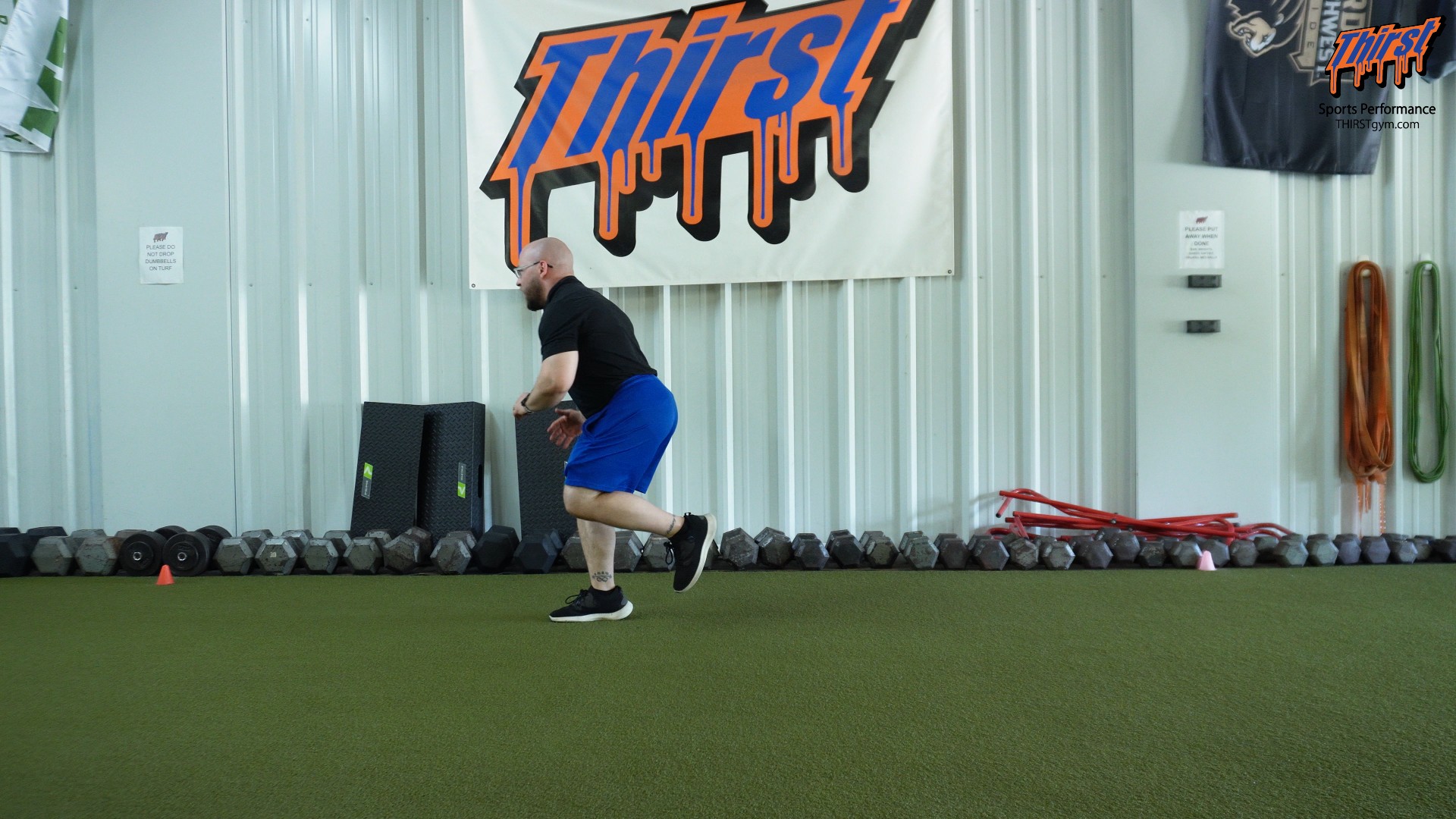Lateral Bound with External Rotation: The Ultimate Plyometric Exercise for Athletic Performance
When it comes to developing explosive lateral movement and rotational power for sports performance, few exercises match the effectiveness of the lateral bound with external rotation. This advanced plyometric movement combines the fundamental benefits of lateral jumping with the added challenge of rotational mechanics, making it an essential exercise for athletes across multiple sports.
Watch the video below on how to maximize this exercise.
What is the Lateral Bound with External Rotation?
The lateral bound with external rotation is a progression of the standard lateral bound exercise that incorporates a 45-degree body rotation during the jumping movement. Unlike traditional lateral bounds where athletes face forward throughout the movement, this variation requires athletes to rotate their torso and hips while maintaining the explosive lateral propulsion that makes lateral bounds so effective.
This exercise challenges athletes on multiple planes of movement simultaneously, combining the frontal plane movement of lateral jumping with the transverse plane movement of rotation. This multi-planar approach better mimics the complex movement patterns athletes encounter in real-world sporting situations.
Essential Prerequisites and Equipment
Before attempting the lateral bound with external rotation, athletes should have a solid foundation in basic plyometric training principles. This includes proper landing mechanics, adequate single-leg stability, and experience with standard lateral bounds. The beauty of this exercise lies in its simplicity regarding equipment needs – all you require is sufficient space to perform lateral jumps safely.
Having a background in general plyometric training is crucial because this exercise demands excellent body control and proprioceptive awareness. Athletes who rush into advanced plyometric movements without proper preparation significantly increase their risk of injury and reduce the exercise’s effectiveness.
Step-by-Step Exercise Technique
The lateral bound with external rotation begins similarly to a standard lateral bound. Start by standing on one leg with your body positioned for explosive lateral movement. The key difference emerges during the jumping phase, where athletes must coordinate the lateral propulsion with a simultaneous 45-degree rotation.
As you initiate the lateral jump from your outside hip, begin rotating your entire body toward the direction you’re jumping. The goal is to land at a 45-degree angle from your starting position, challenging both your ability to generate lateral force and your capacity to control rotational momentum.
The landing phase proves equally important as the takeoff. Athletes must focus on sticking the landing on the opposite leg while maintaining the rotated body position. This requires exceptional hip stability and core control, as the rotational element adds significant complexity to an already challenging single-leg landing.
The external rotation component serves a dual purpose in this exercise. First, it helps open up the hip you’re pushing from, encouraging greater range of motion and power generation. Second, it significantly challenges the landing mechanics of the opposite leg, forcing the hip stabilizers to work harder to control the rotational forces.
Primary Benefits for Athletic Performance
The lateral bound with external rotation delivers multiple performance benefits that translate directly to improved athletic function. Hip stability represents one of the most significant advantages, as athletes develop the strength and coordination necessary to control single-leg landings under rotational stress.
Rotational power development is another crucial benefit, particularly valuable for athletes in sports requiring rapid direction changes and rotational movements. The exercise trains the ability to generate and control rotational forces while maintaining dynamic balance and stability.
The enhancement of landing mechanics cannot be overstated. Many athletic injuries occur during landing phases of jumping and cutting movements. By practicing controlled landings under challenging conditions, athletes develop the neuromuscular patterns necessary for safer movement execution during competition.
Additionally, the exercise strengthens hip musculature responsible for creating stiffness and stability on single legs. This improved hip function translates to better performance in virtually all athletic movements requiring unilateral stability.
Sport-Specific Applications
Baseball and softball players particularly benefit from the lateral bound with external rotation due to the rotational demands of their sports. These athletes must frequently open up from their hips during batting, throwing, and fielding movements. The exercise directly trains these movement patterns while building the explosive power necessary for optimal performance.
Basketball players also find tremendous value in this exercise, as the sport demands constant lateral movement combined with rotational elements. The enhanced stability and directional change capabilities developed through this exercise translate directly to improved on-court performance, particularly in defensive situations and during fast-break scenarios.
The exercise’s benefits extend beyond these primary sports to any athletic endeavor requiring lateral movement, rotation, or single-leg stability. Tennis players, soccer athletes, and martial artists can all incorporate this movement to enhance their performance capabilities.
Programming Recommendations
Effective programming of the lateral bound with external rotation requires careful attention to volume and intensity. The recommended approach involves performing three to five sets of two to five repetitions on each side. This relatively low repetition range reflects the high-intensity nature of the exercise and the importance of maintaining movement quality throughout each repetition.
Quality should always take precedence over quantity when performing this exercise. Athletes must focus intensely on sticking their landings while simultaneously applying maximum lateral force. If movement quality begins to deteriorate, the set should be terminated regardless of the planned repetition count.
The exercise fits well into the power development phase of training sessions, typically performed after a thorough warm-up but before more fatiguing activities. This placement ensures athletes can execute the movement with optimal force production and movement quality.
Conclusion
The lateral bound with external rotation represents an advanced plyometric exercise that delivers exceptional benefits for athletic performance. By combining lateral movement with rotational challenges, this exercise prepares athletes for the complex movement demands of competitive sports while building crucial stability and power capabilities.
Success with this exercise requires patience, proper progression, and unwavering focus on movement quality. Athletes who master the lateral bound with external rotation will find themselves better equipped to handle the dynamic movement challenges their sports demand while reducing injury risk through improved landing mechanics and hip stability.








